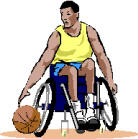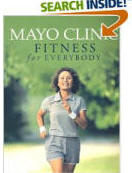Exercising with Health and Physical Challenges
(Do an Internet search on this topic)

Regular exercise helps, not hurts, most people with various health conditions. Physical activity can help increase energy, strength, balance and coordination, as well as ease pain for most individuals.
People become sick or disabled more often from not exercising than from exercising. Those who have chronic diseases, or risk factors for them, may actually improve with regular exercise, but should check with their clinician before increasing their physical activity.
If you plan to work your way up to a vigorous level, check with your clinician first in you are a man over 40 or a woman over 50 or if you have any of the conditions listed below.
Cardiovascular Disease:
· chest pain, angina, congestive heart failure
· irregular, rapid, or fluttery heart beat
· post-heart attack or post-bypass
Breathing Conditions:
· severe shortness of breath, asthma
· infections, such as pneumonia
· emphysema
Joint or bone conditions:
· arthritis, joint swelling, knee or hip replacements
· back or knee pain
· osteoporosis
· paralysis
Other Conditions:
· diabetes (type 1 or type 2) – foot or ankle sores that won’t heal
· deep-vein thrombosis (blood clots)
· hypertension
· pregnancy
· neuromuscular (epilepsy, fibromyalgia, Parkinson’s disease, stroke)
· vision or hearing impairments
How to Manage Fibromyalgia & Chronic Fatigue Syndromes: Fibromyalgia & Chronic Fatigue.pdf and see resources below
Physical Activity is for Every Body
Staying active and fit is one of the great challenges of those with disabilities, but we encourage you to focus on the abled part. Do what you can do, with what you have. Use special equipment if needed. Depending on the disability or health challenge, some parts of the body may be able to lift, stretch and bend more than other parts. You may be able to strengthen some muscle groups or increase range of motion even if you can’t achieve aerobic intensity. The old adage applies here, “use it or lose it”.
Accommodate Injuries or Limitations
Listen to your body and slow down if it says so. If you feel pain beyond a mild discomfort, stop the activity and treat the pain. You can find ways to move safely and grow more fit in spite of your limitations.
It is essential to receive guidance from a physical therapist who can show you how to adapt exercise routines so that you do not injure yourself. They can also provide you with information on how to restore function to an area of your body. I have found physical therapists to be invaluable! Check out The Anatomy of Persistence--How Does Bob Keep Going When Injured?
KNEE PAIN EXPLAINED AND HELPFUL EXERCISES: https://www.knee-pain-explained.com/
Ideas that may help:
· Exercising in water
· Using your upper body muscles if you are unable to walk
· Warming the body (moving your arms or walking 5 minutes) and stretching gently
· Buying good shoes for physical activity and replacing them twice a year
· Finding what works for you. Begin to believe that you are capable. You can do it!
Remember to start slowly.
Gradually increase your efforts.
Be sensible – Don’t overdo it.
Pain: The Cause and the Cure
Despite the best of intentions, exercise-related injuries can still occur. Listed below are the most common muscle injuries and how to treat them.
Pulled muscles:
Also known as muscle strains, these are the most common and most preventable of all sports injuries.
Cause: An over-stretching of the muscle fiber. Most likely to occur when muscle is contracting rapidly against resistance, such as when lifting something heavy, or straining for that backhand tennis shot. Well-conditioned, flexible muscles are less likely to strain.
Treatment: A mild pull can develop during exercise only to cause pain later. Reduce activity, apply heat before exercising and ice afterward. Don’t ignore it. Continued strain can lead to more serious of an injury.
Sore muscles:
Sensitivity or pain that occurs a day or two after exercise.
Cause: A breakdown in muscle fiber from an explosive burst of activity. It is frequently related to eccentric muscle activity: the lowering of an weight as opposed to lifting. Downhill walking or running by an unconditioned person can result in muscle soreness.
Treatment: For mild cases, stretching exercise and a few days of decreased activity will eliminate the pain. The best treatment for muscle soreness is prevention. Start any activity gradually.
Muscle cramps:
Strong, temporary contractions of the muscle, also, known as stitches.
Cause: Cramps are caused by excessive muscle fatigue. They can occur during activity (a side stitch while walking) or later, after activity has ceased (cramped calf muscles while sleeping). Some cramps are the result of dehydration, or in unusual cases, a chemical imbalance.
Treatment: Stop activity and gently stretch the muscle. Gentle massage can help ease the cramp. To avoid cramps, warm up before beginning exercise, drink plenty of water, and avoid exposure to extremes of heat or cold.
Muscle spasms:
Cause: Unlike milder cramps, muscle spasms can last for long periods of time. Almost any type of muscle injury can cause a spasm, including strains, inflammation, or a blow.
Treatment: Rest and heat are the best treatments. Anti-inflammatory drugs may help. When spasm eases up, use gentle stretching exercises to restore mobility.
Tendonitis:
This condition is marked by inflamed tendons, burning, or stabbing pain.
Cause: Sudden overstretching or overuse of unconditioned tendons and muscles.
Treatment: Rest. Ice three times a day for 20 minutes for two days. Then apply heat. Begin gentle stretching after pain subsides. Build muscle strength to prevent future injuries. Wear a support boot (get from MD). I just needed to use one!!
Exercise – When Not To
1. Stop exercising when you feel sick. If you have been ill for over a week with a minor illness, and no fever, resume your exercise routine gradually as you feel up to it.
2. After a serious illness or operation, follow your clinician’s advice about the kind and amount of exercises you should do.
Your clinician, cardiac rehabilitation specialist or physical therapist can give you guidelines for physical activity. The next resource section will list many excellent self-management contacts. Almost all adults, regardless of age or condition, can safely improve their health and independence through regular physical activity.
Managing the Emotional Pain of Chronic Illness
Resources for Managing the Emotional Pain of Illness:
Celebrate Life—New Attitudes for Living with Chronic Illness
Illness can force you to make some painful and dramatic changes. This book teaches you to grieve your losses and embrace the joys of your new beginning. Take control of your illness instead of letting your illness control you.
Kathleen Lewis, Arthritis Foundation, 1999
Fibromyalgia and the Mind Body Spirit Connection
Presents a 7-step practical guide to help you manage widespread muscular pain and fatigue— learn how to use the strength of the connection of your mind, body and spirit to overcome your symptoms, improve your sleep, and feel better than ever before.
William B. Salt II, M.D. and Edwin H. Season, M.D., Parkview Publishing, 2000.
How to Manage Fibromyalgia & Chronic Fatigue Syndromes: Fibromyalgia & Chronic Fatigue.pdf
Living a Healthy Life with Chronic Conditions
Provides comprehensive self-management guidance to assist you in developing an active lifestyle with conditions like heart disease, arthritis, cancer, diabetes, asthma, emphysema and others.
Kate Lorig, RN (Editor) et al, Bull Publishing, 2000.
Visit Kaiser Permanente's
extensive HEALTH ENCYCLOPEDIA:
http://members.kaiserpermanente.org/kpweb/healthency/entrypage.do
Resources for an Active Lifestyle at Any Size or Age with Any Health Challenge
What follows is just a partial list of available resources. We encourage you to visit your local library or health resource center. The most important tool for you to use is your brain—be creative and think of fun ways to be active.
Web sites, books, and videos:
 MAYO
CLINIC Fitness for Everybody is designed to help you achieve the goal of
becoming physically fit, regardless of your age, size, physical ability or
overall health. You'll find information on the various components of fitness and
the specific health benefits of each component, as well as detailed and
practical information on designing a personal fitness program that can be
successful, enjoyable, and cost-effective.
MAYO
CLINIC Fitness for Everybody is designed to help you achieve the goal of
becoming physically fit, regardless of your age, size, physical ability or
overall health. You'll find information on the various components of fitness and
the specific health benefits of each component, as well as detailed and
practical information on designing a personal fitness program that can be
successful, enjoyable, and cost-effective.
I have found it to be an excellent resource that blends theory with practice. It is loaded with pictures that show how to do various exercises and has a comprehensive section of exercising with various medical conditions.
Active at Any Size
From Weight Control Network
Many tips to begin a safe, daily activity program
At NIDDK Web site look under Weight Loss and Control
The Weight-control Information Network
1 WIN Way
Bethesda, MD 20892-3665
(202) 828-1025 or 1-877-946-4627
http://win.niddk.nih.gov/about/
American Council on Exercise
Detailed guidelines on exercising with health challenges and many exercise topics. An electronic newsletter is available.
(ACE) American Council on Exercise
4851 Paramount Drive
San Diego, California 92123
(800) 825-3636
NCPAD (The National Center for Physical Activity and Disability)
http://www.icdri.org/Sports/national_center_on_physical_acti.htm
On Facebook: https://www.facebook.com/nchpad
www.ncpad.org/ For specific conditions and exercises.
Inclusive Fitness Coalition: http://incfit.org/node/37
Are you in need of motivation, support, new ideas and expert advice in regards to physical activity and healthy eating?
This free, personalized, web-based program is designed to help people with mobility limitations, chronic health conditions, and physical disabilities meet their physical activity and nutrition goals.
The Physician and Sports Medicine
Articles on exercise, nutrition, injury prevention, and rehabilitation. Includes an online, searchable journal and resource center.
Exercise: A guide from the National Institute on Aging (80-page book & video is available)
National Institute on Aging
Start and stick with a safe, effective program of stretching, balance, and strength-training exercises. The book is free. See the link below. To order the video send a check, money, or order with credit card for $7.00 to:
To order online: https://go4life.nia.nih.gov/exercise-guide
NIAIC, Dept. W
P.O. Box 8057
Gaithersburg, MD
20898-8057
Canada’s Physical Activity Guide for Older Adults
An excellent guide that offers may tips to maintain health and quality of life.
To order call toll-free (888)-334-9769 or order Online.
http://www.phac-aspc.gc.ca/pau-uap/fitness/downloads.html
Books
Easy Does It Yoga
A complete fitness program for those challenged by age, illness (chronic health conditions), injury, or inactivity. Alice Christensen, America Yoga Association, 1999.
ACSM’s Exercise management for Persons with Chronic Diseases and Disabilities
Provides theoretical and practical information on many chronic diseases and conditions.
Gives clear and concise guidance for developing an exercise program for a person with special health considerations. Human Kinetics, 1997.
Videos
Collage Exercise Videos
Catalog has over 375 videos that are organized in sections: aerobics, muscle toning, stretch, yoga & Tai Chi and a specialty section which contains videos for seniors, pregnant moms, and chronic conditions like: stroke, C.O.P.D., multiple sclerosis, Parkinson’s, osteoporosis, pack pain and arthritis (the Sit and Be Fit series and Chair Dancing series). Contact staff for recommendations.
5390 Main St. NE, Dept 1
Minneapolis, MN 55421-1128
(800)-433-67-69
© 2004, adapted with permission, Kaiser Permanente Northwest Health Education Services, Cultivating Health ™ Everyday Fitness Kit